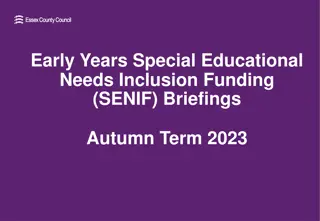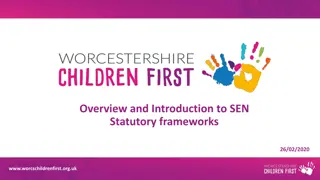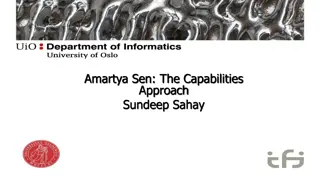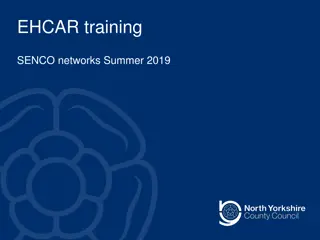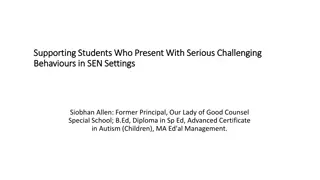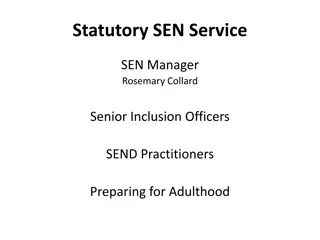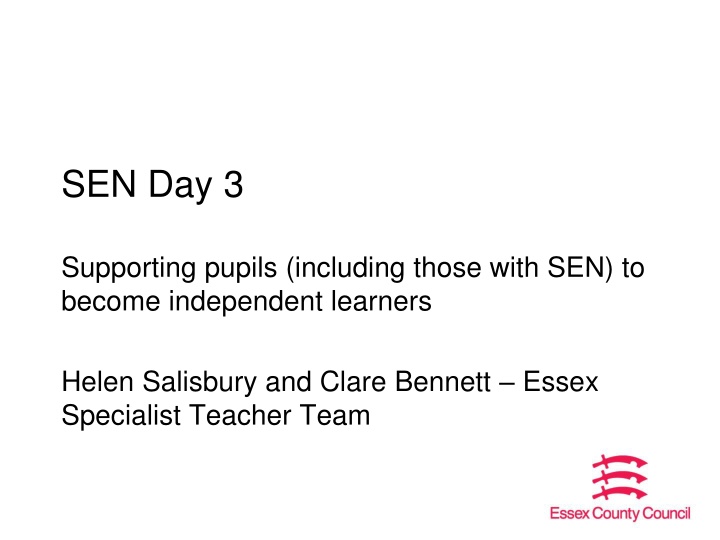
Supporting Pupils to Become Independent Learners - Strategies and Importance
Discover the attributes of an independent learner, explore effective strategies, and understand the crucial role of teachers in fostering independence. Learn why establishing a child's independent learning capacity is vital for meaningful educational progress.
Download Presentation

Please find below an Image/Link to download the presentation.
The content on the website is provided AS IS for your information and personal use only. It may not be sold, licensed, or shared on other websites without obtaining consent from the author. If you encounter any issues during the download, it is possible that the publisher has removed the file from their server.
You are allowed to download the files provided on this website for personal or commercial use, subject to the condition that they are used lawfully. All files are the property of their respective owners.
The content on the website is provided AS IS for your information and personal use only. It may not be sold, licensed, or shared on other websites without obtaining consent from the author.
E N D
Presentation Transcript
SEN Day 3 Supporting pupils (including those with SEN) to become independent learners Helen Salisbury and Clare Bennett Essex Specialist Teacher Team
Outcomes Recognise the attributes of an independent learner and know the role of the teacher in their development Explore the use of the scaffolding triangle to support the development of independent learning Recognise class teacher responsibility for progress of pupils with SEN and identify sources of support to ensure this Identify a range of modifications of classroom practice in order to support pupils with working memory difficulties Have the knowledge and skills necessary to use Blanks Language Scheme to support the development of thinking skills Be equipped with practical strategies to support children to become engaged with word learning 2
What does an independent learner look like? What have you seen? Does it differ with the age of the child? What are the repercussions of non- independent learning? What strategies have you observed that have resulted in children operating as independent learners? 3
Strategy: mind map A central image or title in the centre Think of words associated with the topic (children may need to have pictures, symbols, words or objects to support this) Group / categorise the words/pictures (children may need to use the language of what goes together ); sort them using colour coding e.g. highlight words which go together in the same colour; place pictures in drawn coloured circles or on coloured paper. Draw one branch per group / category and colour code it to match the previous step Add the pictures / words to the correct branch 4
Independent or co-produced? Does it matter? Making a cheese and pickle sandwich
Why is it crucial to establish where the child can operate independently? Unlikely to be able to engage with the task No meaningful learning will take place (apart from learning they can t do the same as their peers ) 6
Zone of proximal development The distance between the actual development level as determined by independent problem solving and the level of potential development as determined through problem solving under adult guidance or in collaboration with more capable peers (Vygotsky, 1978, p86)
Zone Of Proximal Development Student can Student can t Zone of Proximal Development 8
Avoiding teacher meltdown.. If each pupil s ZPD is unique to them, how do I meet such a range of needs? Product success criteria = learning outcome Process success criteria = steps to learning 9
Back to the Cheese and Pickle Sandwich! What would process success criteria look like? NB: steps to learning 10
Scaffolding a tried and tested method to develop independent learning an act of teaching that i) supports the immediate construction of knowledge and ii) provides the basis for the future independent learning of the individual (Holton and Clarke, 2006 p 131) 11
Correcting Little metacognition taking place Telling them exactly what to do is correcting before the error has happened! Ask TA to tally how many times they correct or tell during the times they work with the pupils and then try to reduce No chance to think for themselves 50% of what TAs do comes into this category 13
Modelling The key word for modelling is I Demonstrating the thinking process for child (when the teacher says you , this is giving instruction) Expert demonstrator Talking through what you are doing as you are doing it 14
Questioning The activity must have been modelled before Encourages thought about previous learning by giving clues in the form of a question If they can t get on, child is asked a question if 2-3 clues are given and nothing happens, revert to modelling 15
Prompting No clues Recall of previous learning with no clues how can you find out? Child needs time 16
Self scaffolding Independent learning they know what they need, how to start, what to do when stuck and how to finish/evaluate their work 17
Context-embedded learning. .. And the development of verbal reasoning skills 18
The Cummins Model Cognitively Demanding This is where to move on to when the context is secure - Blanks levels 3 Blanks level 4 Context Embedded Context Reduced Undemanding and abstract what is the learning potential? Pupils with learning difficulties will need to start here Blanks levels 1 and 2 Cognitively Undemanding 19
The Blanks Language Scheme and the development of verbal reasoning skills 20
To think about. as many as half of all pupils identified for SA would not be identified as having SEN if schools focused on improving teaching and learning for all, with individual goals for improvement. (OFSTED, 2010) Making higher quality teaching normally available to the whole class is likely to mean that fewer pupils will require such support. Such improvements in whole class provision tend to be more cost-effective and sustainable. (Code of Practice, 2014. 6:15) 21
Monitor your own provision Teachers standards (especially 5 and 7) The first response: High quality teaching targeted at their areas of weakness (CoP 6:19) 22
Achieving high quality teaching.. Essex: Provision Guidance Toolkit. Find it on SEN pages of infolink or at http://schools.essex.gov.uk/pupils/sen/Provision%20G uidance/Documents/Provision%20Guidance%20v1.4. pdf National: Inclusive teaching checklists but don t try and do it all at once! http://webarchive.nationalarchives.gov.uk/2011020217 1650/http:/nationalstrategies.standards.dcsf.gov.uk/no de/317753 23
Independent? How do you know when a child is working independently? 24
Working Memory The brain s post-it note Verbal (remember instructions, learn language, reading comprehension) Visual-spatial (maths skills, remembering sequences of movements, images, locations) 25
Working Memory Capacity 5-6 years: 2 instructions 7-9 years: 3 instructions 10-12 years: 4 instructions 13-15 years: 5 instructions 16-29 years: 6 instructions (Alloway & Alloway, 2015:7) NB individual variations Working memory measures the potential to learn 26
Reducing the working memory load: Use visuals, concrete apparatus, highlighting, graph paper, visual time-tables, equipment lists, photo prompts etc Make links obvious Track text Present maths problems vertically Shorten activities Give instructions in good time Talk tins/postcards Minimize distractions Shorten instructions Make it multi-sensory Chunk learning Intermittent repetition No multi-tasking 27
Vocabulary Children start school with very different vocabulary size and depth, and starting with poor vocabulary has a cumulative effect. The statistics explored in this book are truly frightening. If a child is in the lowest 20 percent in vocabulary knowledge at age five, and you want them to move to an average level within three years, they would have to learn 20 new words a day, every day, for each of those three years. Jean Gross CBE (Taken from the Foreward to Word Aware by Stephen Parsons and Anna Branagan, 2014, Speechmark Publishing Ltd) 28
To enable children from economically or linguistically deprived backgrounds to keep up with their peers, general exposure to vocabulary as part of normal teaching will not be enough. Stephen Parsons and Anna Branagan, Word Aware 2014, Speechmark Publishing Ltd. 29
Tier 3 - specialised Tier 2- describing Tier 1-core 30
Children as word-learners We need to make this interesting, engaging and challenging. How? 31
Oracy Opportunities for oral language Language that is needed for talking in pairs and talking in groups 32
Learned, used, taught (Gross, J, Time to Talk ; 2013, Routledge) Listening Speaking Reading Writing first most least third next to least next to most Learned Used Taught second next to most next to least third least most 33
Language that is needed for talking in pairs and talking in groups The work of Neil Mercer and his fellow researchers is key in this field. This links well with becoming an independent learner because the children become equipped with the kind of language they need to ask questions, think and reason without adult correction and prompting. 34
Demonstrating Understanding Talking = learning Process not product Alternative Methods of Recording 35
Outcomes Recognise the attributes of an independent learner and know the role of the teacher in their development Explore the use of the scaffolding triangle to support the development of independent learning Recognise class teacher responsibility for progress of pupils with SEN and identify sources of support to ensure this Identify a range of modifications of classroom practice in order to support pupils with working memory difficulties Have the knowledge and skills necessary to use Blanks Language Scheme to support the development of thinking skills Be equipped with practical strategies to support children to become engaged with word learning 36
References Alloway and Alloway (2015): Understanding Working Memory, 2nd edition, Sage. Holton, D and Clarke, D, 2006. Scaffolding and metacognition . International Journal of Mathematical Education in Science and Technology, 37 (2), 127-143 Bosenquet, P. and Radford, J. and Webster, R., (in press) Scaffolding learning for independence: clarifying teacher and TA roles for children with SEN. Learning and Instruction Van de Pol, J., Volman, M. and Beishuizen, J. (2010). Scaffolding in teacher-student interaction: a decade of research. Educational Psychology Review, 22, 271-296 37
References (contd) Gross, J, (2013): Time to Talk, Oxon, Routledge Mercer, N, (2000): Words and Minds: How We Use Language to Think Together, London, Routledge Dawes, L; Mercer, N; Wegerif, R; (2004): Thinking Together, Second Edition, Birmingham, The Questions Publishing Company Ltd. McLachlan, H and Elks, L, (2012): Language Builders 5-11, Elklan Parsons, S, and Branagan, A; (2014): Word Aware: Teaching Vocabulary across the day, across the curriculum, London, Speechmark Publishing Ltd. 38





